Financial Accounting Report: AASB, Impairment, and Lease Analysis
VerifiedAdded on 2020/05/28
|11
|2230
|95
Report
AI Summary
This report presents a comprehensive analysis of a financial accounting assignment. Part A focuses on impairment testing, detailing the assets subject to testing (goodwill, brand names, receivables, property, plant, and equipment), the testing methodology, and the role of management estimates in determining recoverable values and pre-tax discount rates. It also addresses the subjectivity inherent in the process and provides insights into the company's approach to intangible assets with definite and indefinite lives, referencing AASB 13 on Fair Value Measurement. Part B examines lease accounting, specifically addressing the historical treatment of operating and financial leases under previous accounting standards, the reasons behind the chairperson of the AASB's belief that the former standards did not reflect economic reality, and the impact of different accounting treatments on airline companies. It also discusses the advantages and disadvantages of the new accounting standards for both companies and investors.
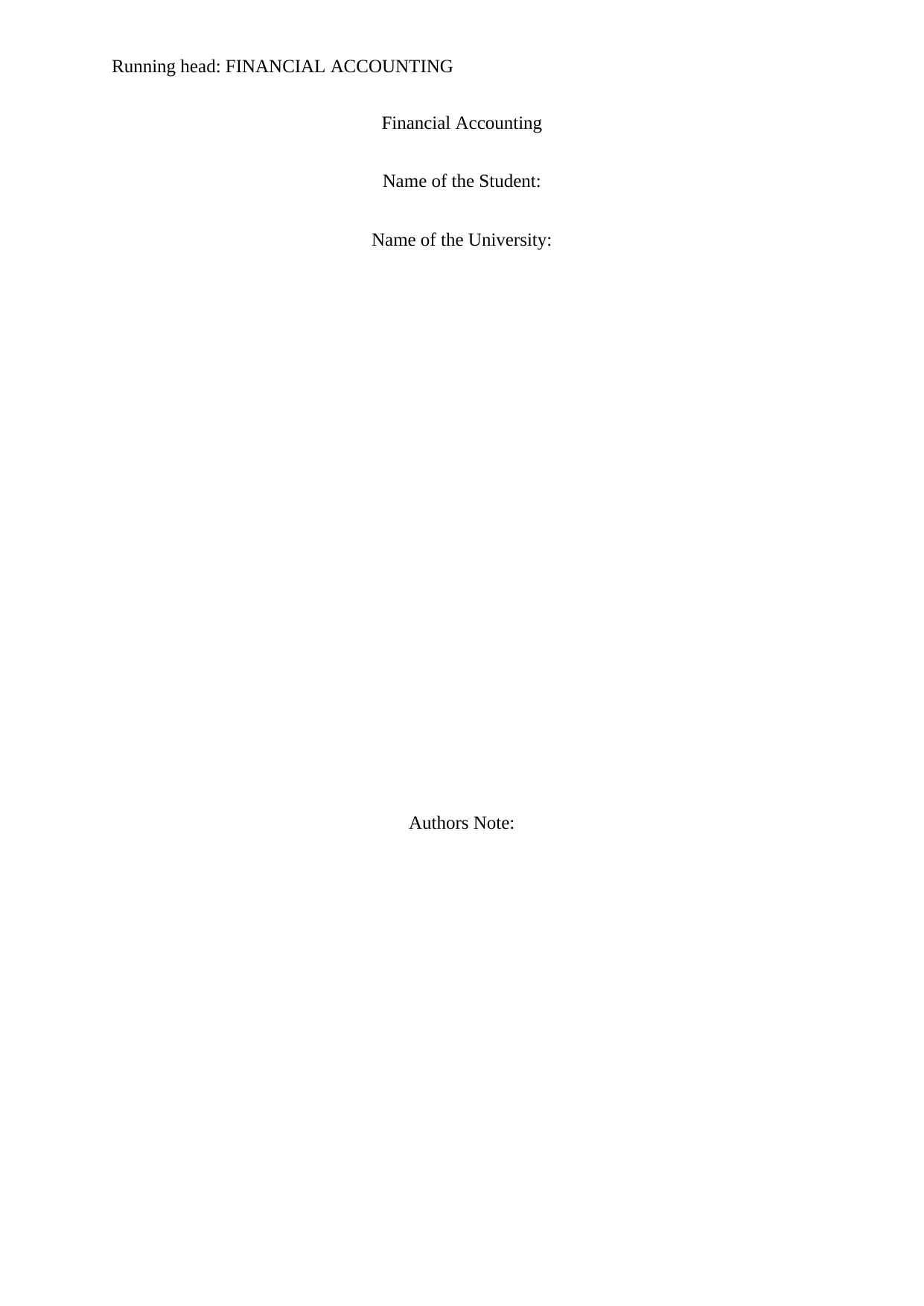
Running head: FINANCIAL ACCOUNTING
Financial Accounting
Name of the Student:
Name of the University:
Authors Note:
Financial Accounting
Name of the Student:
Name of the University:
Authors Note:
Paraphrase This Document
Need a fresh take? Get an instant paraphrase of this document with our AI Paraphraser
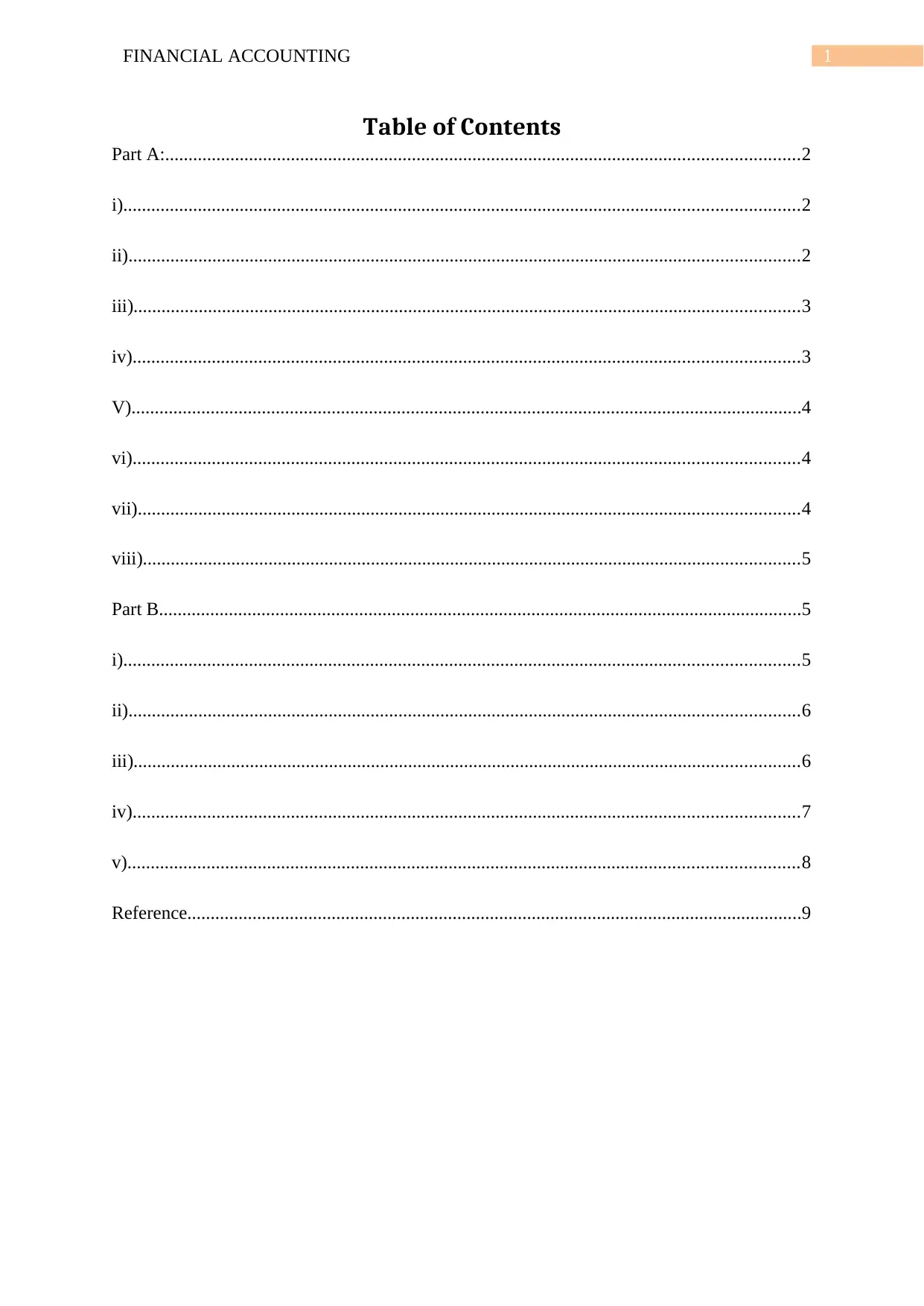
1FINANCIAL ACCOUNTING
Table of Contents
Part A:........................................................................................................................................2
i).................................................................................................................................................2
ii)................................................................................................................................................2
iii)...............................................................................................................................................3
iv)...............................................................................................................................................3
V)................................................................................................................................................4
vi)...............................................................................................................................................4
vii)..............................................................................................................................................4
viii).............................................................................................................................................5
Part B..........................................................................................................................................5
i).................................................................................................................................................5
ii)................................................................................................................................................6
iii)...............................................................................................................................................6
iv)...............................................................................................................................................7
v)................................................................................................................................................8
Reference....................................................................................................................................9
Table of Contents
Part A:........................................................................................................................................2
i).................................................................................................................................................2
ii)................................................................................................................................................2
iii)...............................................................................................................................................3
iv)...............................................................................................................................................3
V)................................................................................................................................................4
vi)...............................................................................................................................................4
vii)..............................................................................................................................................4
viii).............................................................................................................................................5
Part B..........................................................................................................................................5
i).................................................................................................................................................5
ii)................................................................................................................................................6
iii)...............................................................................................................................................6
iv)...............................................................................................................................................7
v)................................................................................................................................................8
Reference....................................................................................................................................9
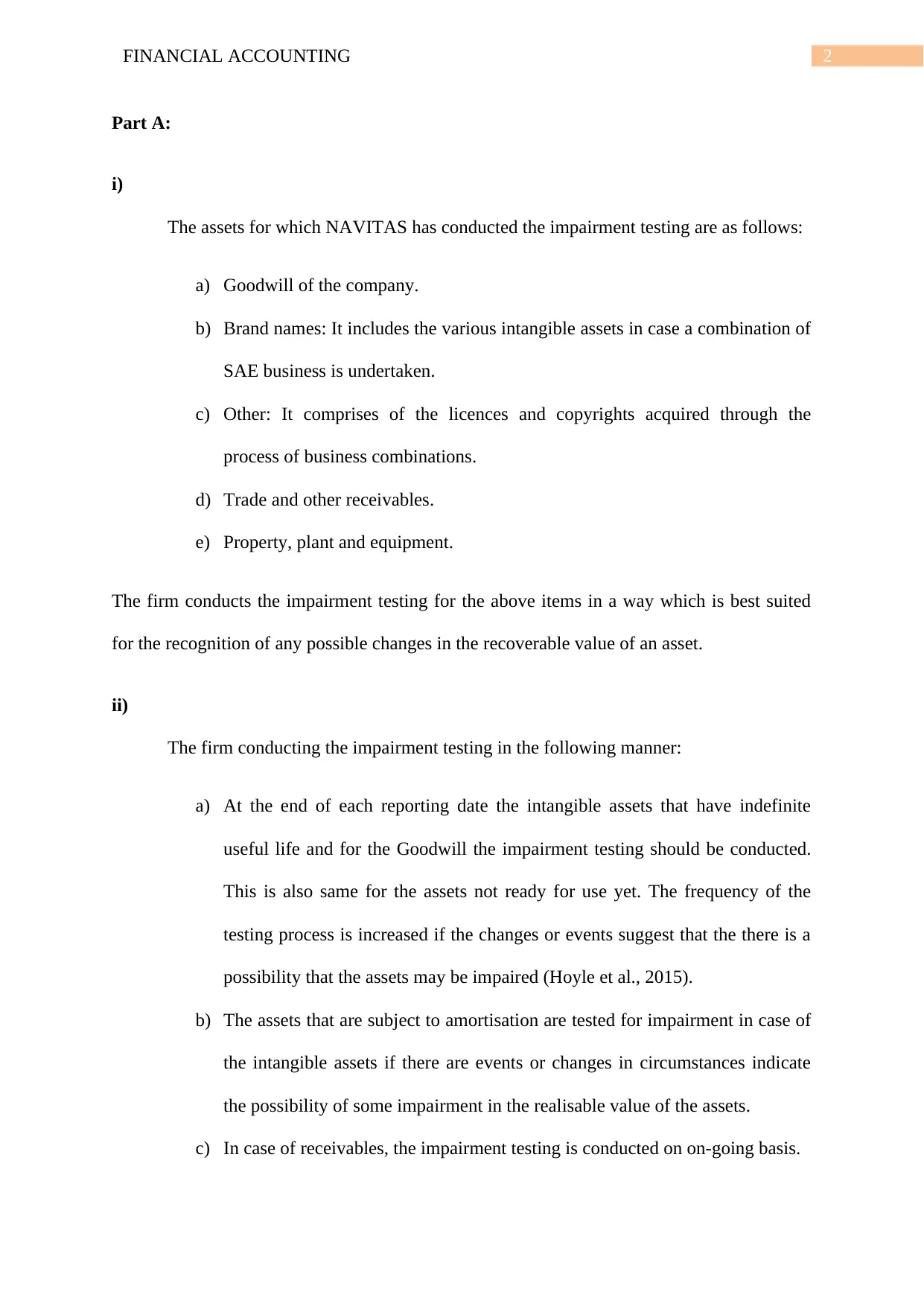
2FINANCIAL ACCOUNTING
Part A:
i)
The assets for which NAVITAS has conducted the impairment testing are as follows:
a) Goodwill of the company.
b) Brand names: It includes the various intangible assets in case a combination of
SAE business is undertaken.
c) Other: It comprises of the licences and copyrights acquired through the
process of business combinations.
d) Trade and other receivables.
e) Property, plant and equipment.
The firm conducts the impairment testing for the above items in a way which is best suited
for the recognition of any possible changes in the recoverable value of an asset.
ii)
The firm conducting the impairment testing in the following manner:
a) At the end of each reporting date the intangible assets that have indefinite
useful life and for the Goodwill the impairment testing should be conducted.
This is also same for the assets not ready for use yet. The frequency of the
testing process is increased if the changes or events suggest that the there is a
possibility that the assets may be impaired (Hoyle et al., 2015).
b) The assets that are subject to amortisation are tested for impairment in case of
the intangible assets if there are events or changes in circumstances indicate
the possibility of some impairment in the realisable value of the assets.
c) In case of receivables, the impairment testing is conducted on on-going basis.
Part A:
i)
The assets for which NAVITAS has conducted the impairment testing are as follows:
a) Goodwill of the company.
b) Brand names: It includes the various intangible assets in case a combination of
SAE business is undertaken.
c) Other: It comprises of the licences and copyrights acquired through the
process of business combinations.
d) Trade and other receivables.
e) Property, plant and equipment.
The firm conducts the impairment testing for the above items in a way which is best suited
for the recognition of any possible changes in the recoverable value of an asset.
ii)
The firm conducting the impairment testing in the following manner:
a) At the end of each reporting date the intangible assets that have indefinite
useful life and for the Goodwill the impairment testing should be conducted.
This is also same for the assets not ready for use yet. The frequency of the
testing process is increased if the changes or events suggest that the there is a
possibility that the assets may be impaired (Hoyle et al., 2015).
b) The assets that are subject to amortisation are tested for impairment in case of
the intangible assets if there are events or changes in circumstances indicate
the possibility of some impairment in the realisable value of the assets.
c) In case of receivables, the impairment testing is conducted on on-going basis.
⊘ This is a preview!⊘
Do you want full access?
Subscribe today to unlock all pages.

Trusted by 1+ million students worldwide

3FINANCIAL ACCOUNTING
d) If the events or changes in the circumstances indicate that, the value of the
assets may be impaired then impairment testing is conducted for plant,
property and equipment.
e) The impairment losses booked in the prior period in respect of the goodwill or
other intangible assets at each reporting date to find out whether their amount
has reduced or they have become non-existent.
iii)
The company has not recorded any impairment expenditure for the year 2016 and 2017.
iv)
For the purpose of conducting impairment testing the management has to make estimates
about the recoverable value of the assets. An estimation is made regarding the realisable
value of the Cash Generating Unit if it is not directly possible to estimate the recoverable
amount of the asset. It should be noted that the higher of fair value of asset less cost of
disposal and value in use is regarded as the recoverable value of an asset or CGU is taken to
be. In computation of value in use the management has to estimate the future cash flows of
the asset and also the pre-tax discount rate (Cortesi et al., 2015). The pre-tax discount rate is
estimated by the management by assuming the risk that is specific to the asset or the CGU.
The pre-tax discount rates are used in discounting the estimated future cash flows of the
assets or CGU. In addition to this, the current assessment of the markets time value of money
is used for the estimation.
V)
Yes there is a lot of subjectivity involved in the process of impairment testing. The period
after which the impairment testing has to be conducted depends upon the subjective
judgement of the management. Further the realisable value of the assets and the discounting
d) If the events or changes in the circumstances indicate that, the value of the
assets may be impaired then impairment testing is conducted for plant,
property and equipment.
e) The impairment losses booked in the prior period in respect of the goodwill or
other intangible assets at each reporting date to find out whether their amount
has reduced or they have become non-existent.
iii)
The company has not recorded any impairment expenditure for the year 2016 and 2017.
iv)
For the purpose of conducting impairment testing the management has to make estimates
about the recoverable value of the assets. An estimation is made regarding the realisable
value of the Cash Generating Unit if it is not directly possible to estimate the recoverable
amount of the asset. It should be noted that the higher of fair value of asset less cost of
disposal and value in use is regarded as the recoverable value of an asset or CGU is taken to
be. In computation of value in use the management has to estimate the future cash flows of
the asset and also the pre-tax discount rate (Cortesi et al., 2015). The pre-tax discount rate is
estimated by the management by assuming the risk that is specific to the asset or the CGU.
The pre-tax discount rates are used in discounting the estimated future cash flows of the
assets or CGU. In addition to this, the current assessment of the markets time value of money
is used for the estimation.
V)
Yes there is a lot of subjectivity involved in the process of impairment testing. The period
after which the impairment testing has to be conducted depends upon the subjective
judgement of the management. Further the realisable value of the assets and the discounting
Paraphrase This Document
Need a fresh take? Get an instant paraphrase of this document with our AI Paraphraser

4FINANCIAL ACCOUNTING
rate all depend upon the judgement of the management. This can significantly impact the
outcome of the impairment testing (Beatty & Liao, 2014). There may be instances where the
management is unable to gauge the impact of the changes in the circumstances or events on
the value of the assets.
vi)
The thing I found interesting how the company’s assign the recognisable value to the
assets whose recognisable value is not readily available, by finding out the recognisable value
of the Cash Generating Units of the class of assets it belongs to. The surprising thing was
that it is completely on the judgement of the management to decide when to increase the
frequency of the impairment testing base on the changes taking place in the circumstances
(Com, 2016).
vii)
The new insight that I got about impairment testing was that the company divide their
intangible assets into two groups i.e. one with definite life and one with indefinite life and
depending on this the interval of impairment testing is decided.
The assets having an indefinite life like Brand Names in this case are tested for
impairment annually and in presence of an indicator the interval is increased. Whereas in case
of intangible assets having definite life impairment testing is conducted if it is indicated that
the assets may be impaired.
viii)
AASB 13 deals with the concept of Fair Value Measurement. It is concerned with the
amount that is going to be realised from the sale of an asset or transfer of a liability. It lays
down the provisions with respect to the procedures to be followed by the management in
determination of the value of that can be realised.
rate all depend upon the judgement of the management. This can significantly impact the
outcome of the impairment testing (Beatty & Liao, 2014). There may be instances where the
management is unable to gauge the impact of the changes in the circumstances or events on
the value of the assets.
vi)
The thing I found interesting how the company’s assign the recognisable value to the
assets whose recognisable value is not readily available, by finding out the recognisable value
of the Cash Generating Units of the class of assets it belongs to. The surprising thing was
that it is completely on the judgement of the management to decide when to increase the
frequency of the impairment testing base on the changes taking place in the circumstances
(Com, 2016).
vii)
The new insight that I got about impairment testing was that the company divide their
intangible assets into two groups i.e. one with definite life and one with indefinite life and
depending on this the interval of impairment testing is decided.
The assets having an indefinite life like Brand Names in this case are tested for
impairment annually and in presence of an indicator the interval is increased. Whereas in case
of intangible assets having definite life impairment testing is conducted if it is indicated that
the assets may be impaired.
viii)
AASB 13 deals with the concept of Fair Value Measurement. It is concerned with the
amount that is going to be realised from the sale of an asset or transfer of a liability. It lays
down the provisions with respect to the procedures to be followed by the management in
determination of the value of that can be realised.

5FINANCIAL ACCOUNTING
Part B
i)
The reason for the belief of the chairperson of the AASB that the former accounting
standard relating to leases did not reflect the economic reality is the separate treatment of the
operating lease transactions and the financial lease transactions. Previously the companies in
their financial statements were not supposed to record the assets acquired and the resultant
financial obligation. Only the assets acquired by way of financial lease transactions were to
be recorded in the financial statements. Despite the fact that the obligations arising out of
acquisition of assets by way of operating lease is just as real as those arising out of financial
lease, the recording of the same was prohibited. This created a loophole in the true and fair
view reflected by the financial statements (Weygandt et al., 2015). The shareholders were
generally unaware about the obligations the company has incurred by way of acquiring assets
via operating lease as the same was not recorded in the financial statements. It can be said
that the financial statements prepared as per the former accounting standards were not
capable of showing the true and fair view of the company’s performance and the financial
position.
ii)
The former accounting standard prescribed different accounting treatment for the finance
lease transactions and operating lease transactions. As per the former standards, only the
assets acquired by way of financial lease were to be recorded along with their resultant
obligations in the statements of accounts of the company. The assets and the corresponding
liability in case of acquisition by way of operating lease were not to be recorded in the
financial statements of the company. But, the liability or obligation created by the operating
lease transactions were as much real as that of financial lease transaction and increased the
Part B
i)
The reason for the belief of the chairperson of the AASB that the former accounting
standard relating to leases did not reflect the economic reality is the separate treatment of the
operating lease transactions and the financial lease transactions. Previously the companies in
their financial statements were not supposed to record the assets acquired and the resultant
financial obligation. Only the assets acquired by way of financial lease transactions were to
be recorded in the financial statements. Despite the fact that the obligations arising out of
acquisition of assets by way of operating lease is just as real as those arising out of financial
lease, the recording of the same was prohibited. This created a loophole in the true and fair
view reflected by the financial statements (Weygandt et al., 2015). The shareholders were
generally unaware about the obligations the company has incurred by way of acquiring assets
via operating lease as the same was not recorded in the financial statements. It can be said
that the financial statements prepared as per the former accounting standards were not
capable of showing the true and fair view of the company’s performance and the financial
position.
ii)
The former accounting standard prescribed different accounting treatment for the finance
lease transactions and operating lease transactions. As per the former standards, only the
assets acquired by way of financial lease were to be recorded along with their resultant
obligations in the statements of accounts of the company. The assets and the corresponding
liability in case of acquisition by way of operating lease were not to be recorded in the
financial statements of the company. But, the liability or obligation created by the operating
lease transactions were as much real as that of financial lease transaction and increased the
⊘ This is a preview!⊘
Do you want full access?
Subscribe today to unlock all pages.

Trusted by 1+ million students worldwide
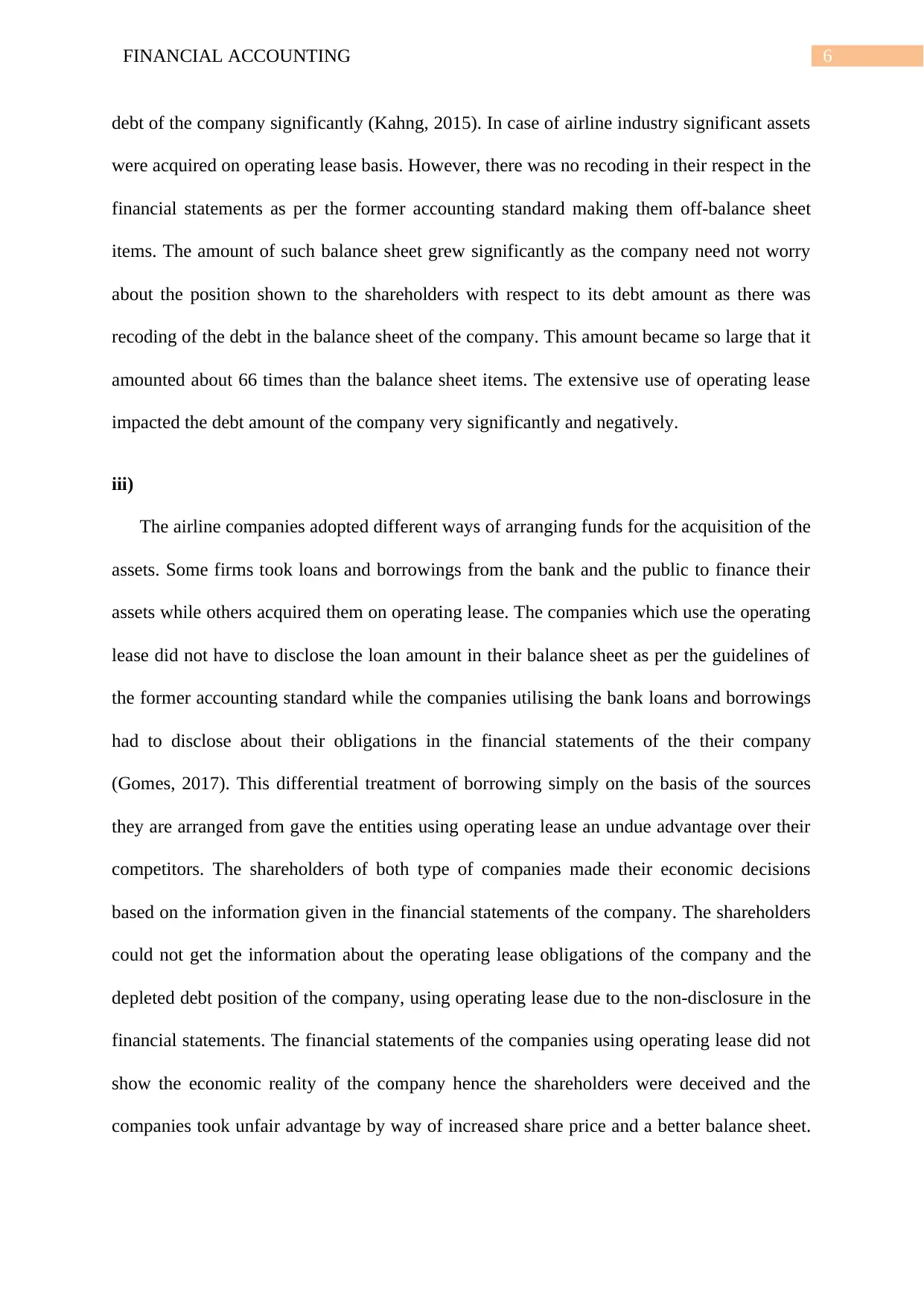
6FINANCIAL ACCOUNTING
debt of the company significantly (Kahng, 2015). In case of airline industry significant assets
were acquired on operating lease basis. However, there was no recoding in their respect in the
financial statements as per the former accounting standard making them off-balance sheet
items. The amount of such balance sheet grew significantly as the company need not worry
about the position shown to the shareholders with respect to its debt amount as there was
recoding of the debt in the balance sheet of the company. This amount became so large that it
amounted about 66 times than the balance sheet items. The extensive use of operating lease
impacted the debt amount of the company very significantly and negatively.
iii)
The airline companies adopted different ways of arranging funds for the acquisition of the
assets. Some firms took loans and borrowings from the bank and the public to finance their
assets while others acquired them on operating lease. The companies which use the operating
lease did not have to disclose the loan amount in their balance sheet as per the guidelines of
the former accounting standard while the companies utilising the bank loans and borrowings
had to disclose about their obligations in the financial statements of the their company
(Gomes, 2017). This differential treatment of borrowing simply on the basis of the sources
they are arranged from gave the entities using operating lease an undue advantage over their
competitors. The shareholders of both type of companies made their economic decisions
based on the information given in the financial statements of the company. The shareholders
could not get the information about the operating lease obligations of the company and the
depleted debt position of the company, using operating lease due to the non-disclosure in the
financial statements. The financial statements of the companies using operating lease did not
show the economic reality of the company hence the shareholders were deceived and the
companies took unfair advantage by way of increased share price and a better balance sheet.
debt of the company significantly (Kahng, 2015). In case of airline industry significant assets
were acquired on operating lease basis. However, there was no recoding in their respect in the
financial statements as per the former accounting standard making them off-balance sheet
items. The amount of such balance sheet grew significantly as the company need not worry
about the position shown to the shareholders with respect to its debt amount as there was
recoding of the debt in the balance sheet of the company. This amount became so large that it
amounted about 66 times than the balance sheet items. The extensive use of operating lease
impacted the debt amount of the company very significantly and negatively.
iii)
The airline companies adopted different ways of arranging funds for the acquisition of the
assets. Some firms took loans and borrowings from the bank and the public to finance their
assets while others acquired them on operating lease. The companies which use the operating
lease did not have to disclose the loan amount in their balance sheet as per the guidelines of
the former accounting standard while the companies utilising the bank loans and borrowings
had to disclose about their obligations in the financial statements of the their company
(Gomes, 2017). This differential treatment of borrowing simply on the basis of the sources
they are arranged from gave the entities using operating lease an undue advantage over their
competitors. The shareholders of both type of companies made their economic decisions
based on the information given in the financial statements of the company. The shareholders
could not get the information about the operating lease obligations of the company and the
depleted debt position of the company, using operating lease due to the non-disclosure in the
financial statements. The financial statements of the companies using operating lease did not
show the economic reality of the company hence the shareholders were deceived and the
companies took unfair advantage by way of increased share price and a better balance sheet.
Paraphrase This Document
Need a fresh take? Get an instant paraphrase of this document with our AI Paraphraser
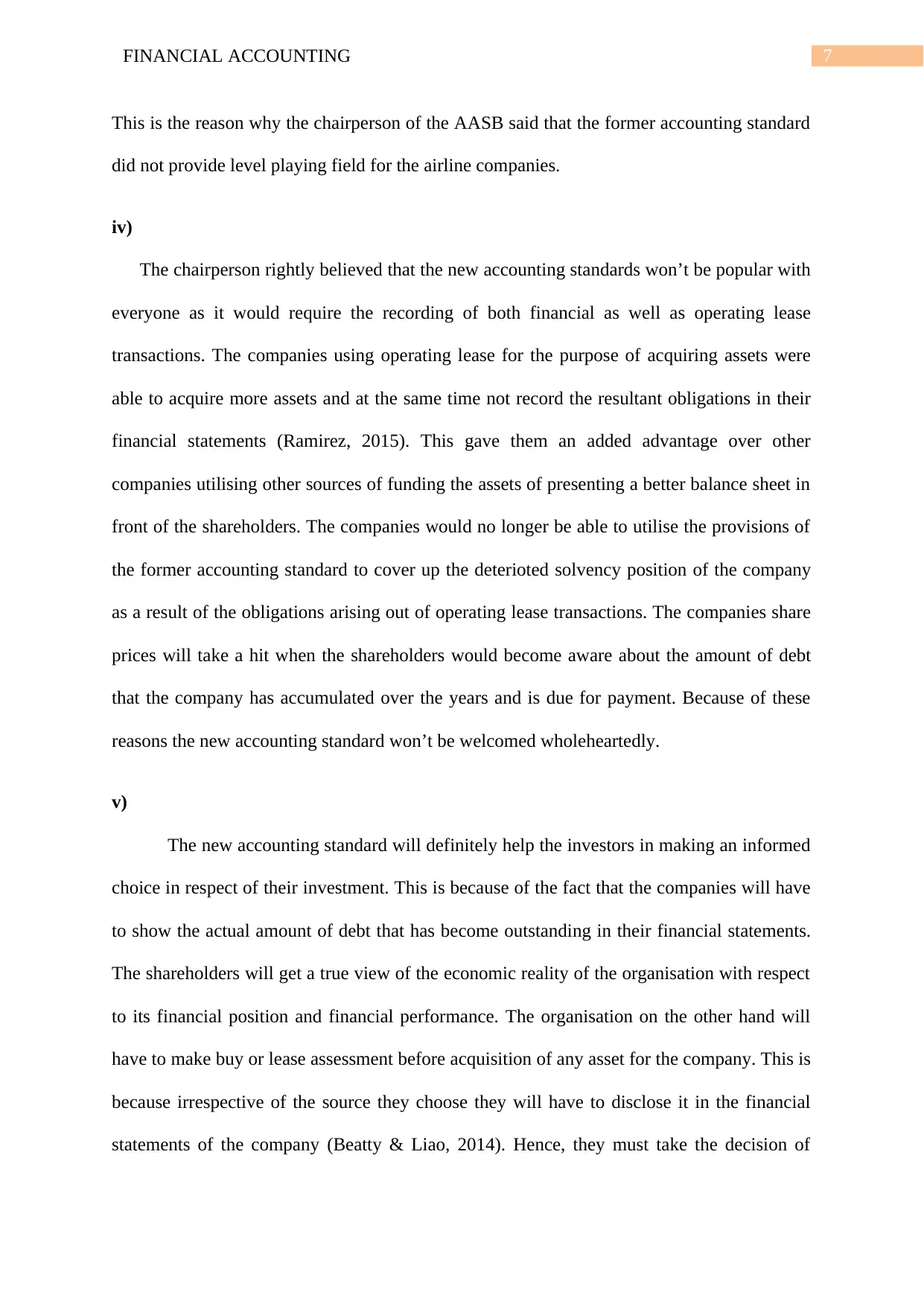
7FINANCIAL ACCOUNTING
This is the reason why the chairperson of the AASB said that the former accounting standard
did not provide level playing field for the airline companies.
iv)
The chairperson rightly believed that the new accounting standards won’t be popular with
everyone as it would require the recording of both financial as well as operating lease
transactions. The companies using operating lease for the purpose of acquiring assets were
able to acquire more assets and at the same time not record the resultant obligations in their
financial statements (Ramirez, 2015). This gave them an added advantage over other
companies utilising other sources of funding the assets of presenting a better balance sheet in
front of the shareholders. The companies would no longer be able to utilise the provisions of
the former accounting standard to cover up the deterioted solvency position of the company
as a result of the obligations arising out of operating lease transactions. The companies share
prices will take a hit when the shareholders would become aware about the amount of debt
that the company has accumulated over the years and is due for payment. Because of these
reasons the new accounting standard won’t be welcomed wholeheartedly.
v)
The new accounting standard will definitely help the investors in making an informed
choice in respect of their investment. This is because of the fact that the companies will have
to show the actual amount of debt that has become outstanding in their financial statements.
The shareholders will get a true view of the economic reality of the organisation with respect
to its financial position and financial performance. The organisation on the other hand will
have to make buy or lease assessment before acquisition of any asset for the company. This is
because irrespective of the source they choose they will have to disclose it in the financial
statements of the company (Beatty & Liao, 2014). Hence, they must take the decision of
This is the reason why the chairperson of the AASB said that the former accounting standard
did not provide level playing field for the airline companies.
iv)
The chairperson rightly believed that the new accounting standards won’t be popular with
everyone as it would require the recording of both financial as well as operating lease
transactions. The companies using operating lease for the purpose of acquiring assets were
able to acquire more assets and at the same time not record the resultant obligations in their
financial statements (Ramirez, 2015). This gave them an added advantage over other
companies utilising other sources of funding the assets of presenting a better balance sheet in
front of the shareholders. The companies would no longer be able to utilise the provisions of
the former accounting standard to cover up the deterioted solvency position of the company
as a result of the obligations arising out of operating lease transactions. The companies share
prices will take a hit when the shareholders would become aware about the amount of debt
that the company has accumulated over the years and is due for payment. Because of these
reasons the new accounting standard won’t be welcomed wholeheartedly.
v)
The new accounting standard will definitely help the investors in making an informed
choice in respect of their investment. This is because of the fact that the companies will have
to show the actual amount of debt that has become outstanding in their financial statements.
The shareholders will get a true view of the economic reality of the organisation with respect
to its financial position and financial performance. The organisation on the other hand will
have to make buy or lease assessment before acquisition of any asset for the company. This is
because irrespective of the source they choose they will have to disclose it in the financial
statements of the company (Beatty & Liao, 2014). Hence, they must take the decision of

8FINANCIAL ACCOUNTING
borrowing the amount by keeping in mind that how it is going to affect the solvency position
of the company. the new standard has paved way for the shareholders to know the economic
reality of the companies by lifting the practice of differential accounting treatment for
operating lease transaction and financial lease transaction. With its advent disclosures in
respect of both types of leases will be required.
borrowing the amount by keeping in mind that how it is going to affect the solvency position
of the company. the new standard has paved way for the shareholders to know the economic
reality of the companies by lifting the practice of differential accounting treatment for
operating lease transaction and financial lease transaction. With its advent disclosures in
respect of both types of leases will be required.
⊘ This is a preview!⊘
Do you want full access?
Subscribe today to unlock all pages.

Trusted by 1+ million students worldwide
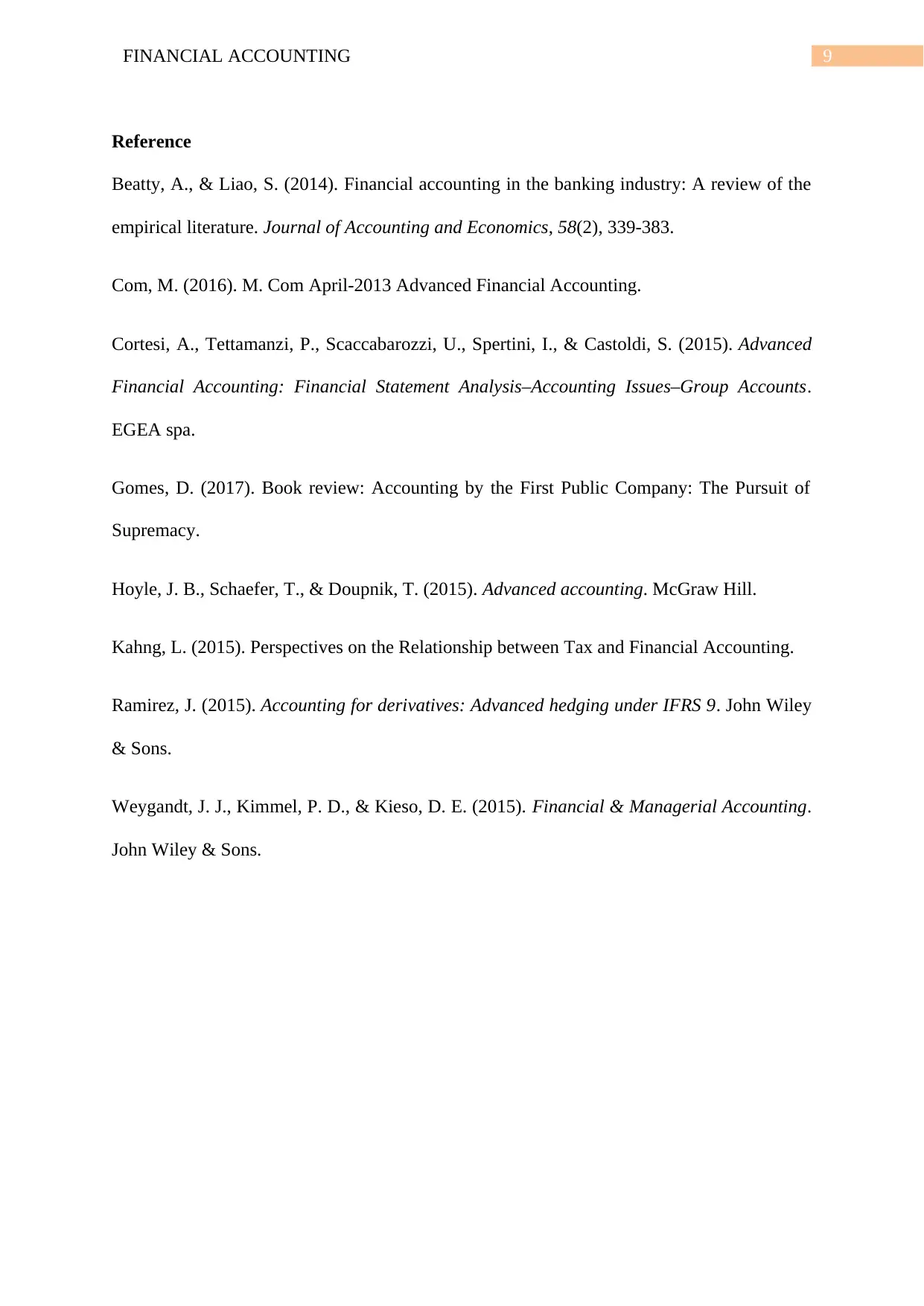
9FINANCIAL ACCOUNTING
Reference
Beatty, A., & Liao, S. (2014). Financial accounting in the banking industry: A review of the
empirical literature. Journal of Accounting and Economics, 58(2), 339-383.
Com, M. (2016). M. Com April-2013 Advanced Financial Accounting.
Cortesi, A., Tettamanzi, P., Scaccabarozzi, U., Spertini, I., & Castoldi, S. (2015). Advanced
Financial Accounting: Financial Statement Analysis–Accounting Issues–Group Accounts.
EGEA spa.
Gomes, D. (2017). Book review: Accounting by the First Public Company: The Pursuit of
Supremacy.
Hoyle, J. B., Schaefer, T., & Doupnik, T. (2015). Advanced accounting. McGraw Hill.
Kahng, L. (2015). Perspectives on the Relationship between Tax and Financial Accounting.
Ramirez, J. (2015). Accounting for derivatives: Advanced hedging under IFRS 9. John Wiley
& Sons.
Weygandt, J. J., Kimmel, P. D., & Kieso, D. E. (2015). Financial & Managerial Accounting.
John Wiley & Sons.
Reference
Beatty, A., & Liao, S. (2014). Financial accounting in the banking industry: A review of the
empirical literature. Journal of Accounting and Economics, 58(2), 339-383.
Com, M. (2016). M. Com April-2013 Advanced Financial Accounting.
Cortesi, A., Tettamanzi, P., Scaccabarozzi, U., Spertini, I., & Castoldi, S. (2015). Advanced
Financial Accounting: Financial Statement Analysis–Accounting Issues–Group Accounts.
EGEA spa.
Gomes, D. (2017). Book review: Accounting by the First Public Company: The Pursuit of
Supremacy.
Hoyle, J. B., Schaefer, T., & Doupnik, T. (2015). Advanced accounting. McGraw Hill.
Kahng, L. (2015). Perspectives on the Relationship between Tax and Financial Accounting.
Ramirez, J. (2015). Accounting for derivatives: Advanced hedging under IFRS 9. John Wiley
& Sons.
Weygandt, J. J., Kimmel, P. D., & Kieso, D. E. (2015). Financial & Managerial Accounting.
John Wiley & Sons.
Paraphrase This Document
Need a fresh take? Get an instant paraphrase of this document with our AI Paraphraser

10FINANCIAL ACCOUNTING
1 out of 11
Related Documents
Your All-in-One AI-Powered Toolkit for Academic Success.
+13062052269
info@desklib.com
Available 24*7 on WhatsApp / Email
![[object Object]](/_next/static/media/star-bottom.7253800d.svg)
Unlock your academic potential
Copyright © 2020–2025 A2Z Services. All Rights Reserved. Developed and managed by ZUCOL.





